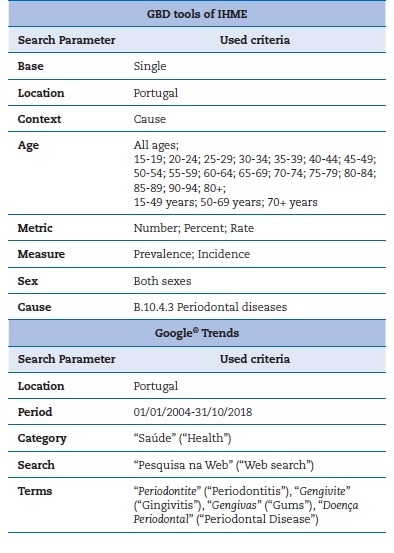Introduction
The burden of periodontal diseases among the worldwide population flags a significant public health problem. Periodontal diseases are one of the most prevalent pathologies in the world, along with caries, and have maintained continuous alarming high levels,1-6with a huge impact on people’s daily lives. They are the 6th most common disease worldwide.2 Besides affecting the patient’s quality of life, periodontal diseases also affect their aesthetic appearance and self-awareness, as the gum level is one of the items considered in several aesthetic self-perception studies.7-9
In Portugal, according to the last Oral Health National Survey by the Portuguese Directorate-General of Health (DGS), in 2015, the prevalence of periodontitis was 10.8% and 15.3% in the age groups of 35-44 and 65-74 years old, respectively.10However, the periodontal partial recording protocol used in that study has a high bias power, as previously demonstrated.11
The Global Burden of Disease (GBD) is one of the largest international scientific collaborations in the world that identifies and describes the biggest health problems worldwide.
Since 1990, the GBD provides a tool to quantify health loss from hundreds of diseases, injuries and risk factors, and allows comparisons over time, across age groups, and between populations. Moreover, this instrument helps governments, scientists and partners in assessing health trends globally and in particular regions and countries.
GoogleR Trends is a unique, powerful and considerably interesting tool for online search trends that allows the user to see how frequently a specific keyword, subjects, and phrases have been queried over a specific period of time. This tool can be used for comparative keyword research and to discover event-triggered spikes in keyword search volume. Consequently, this database may be very useful to investigate the population. GoogleR Trends uses a portion of specific term searches (‘‘keyword” or ‘‘search term”) and then analyses the GoogleR search results in a given geographical location and a defined timeframe. Then, aGoogleR Trends Index is assigned to the keyword. This index ranges from 0 to 100, where 100 represents the highest share of the term over a time series.
The epidemiologic potentialities of Google Trends have been studied in a wide variety of medical areas, from the assessment of epidemic peaks and outbreaks to monitoring.12-18Regarding oral health, Google trends and public awareness are topics that have gained interest, but periodontal diseases have never been addressed in this context.
This study will pay heed to the progression of periodontal disease prevalence in Portugal and correspondent digital national awareness, between 2004 and 2017, using data from the GBD, the DGS, and GoogleR Trends.
Material and methods
In order to obtain Portuguese national data, the GBD tools of the Institute for Health Metrics and Evaluation (IHME) (http://ghdx.healthdata.org) were used based on the parameters specified inTable 1. The search was done on the 8th of November of 2018. A stable link with specific parameters was generated to perpetuate the research carried out: http://ghdx.healthdata.org/gbd-results-tool?params=gbd-api-2017-permalink/61cb17b687216830e3c9975ae2ec3151
To appraise the public awareness for search terms related to periodontal diseases, we used the following strategy on the GoogleR Trends comparison tool: https://trends.google.pt/trends/explore?cat=45&date=2004-01-01%202018-10-31&geo=PT&q=periodontite,gengivite,gengivas,doen%C3%A7a%20periodontal. The search was performed in Portuguese (Table 1).
The DGS National Surveys were obtained from the official oral-health website of the DGS (https://www.dgs.pt/pns-e-programas/programas-de-saude/saude-oral.aspx). Three national surveys from the National Oral Health Promotion Program (PNPSO), from 2005, 2008 and 2015, respectively, were included.10,19,20Data were analyzed using the IBM SPSS Statistics software, version 25.0, for Windows (IBM Corp., Armonk, NY, USA). Bivariate analysis based on the Spearman’s rank correlation coefficient was conducted in order to assess the correlation, over time, between GoogleR Trends search terms and GoogleR Trends data vs. GBD data. The level of significance was set at 5%.
Results
The evolution of periodontal disease prevalence over the fourteen years studied (2004-2017) is shown inFigure 1. Overall, the periodontitis prevalence increased slightly in the Portuguese population from 11.3% to 11.7% during this period. Regarding age, the prevalence of periodontitis decreased in the age range of 50-69 years but remained similar in 15-49 and 70+ years.
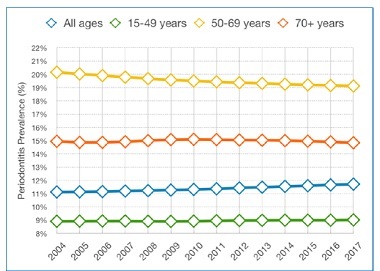
Figure 1 Evolution of periodontal disease prevalence in Portugal between 2004 and 2017, according to the Global Burden of Disease.
When comparing these data with global values, the Portuguese periodontitis prevalence was higher than the world average for those fourteen years, being 8.5% higher in 2017 (Figures2-3).
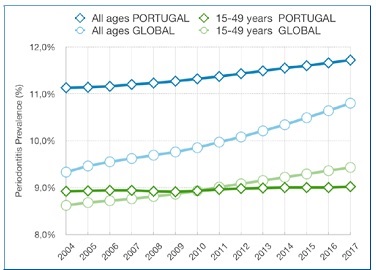
Figure 2 Evolution of global and Portuguese periodontitis prevalence between 2004 and 2017, for all ages and the age range 15-49 years, according to the Global Burden of Disease.
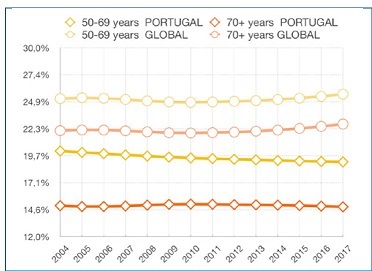
Figure 3 Evolution of global and Portuguese periodontitis prevalence between 2004 and 2017, for the age ranges 50-69 and 70+ years, according to the Global Burden of Disease.
Figure 4represents the evolution of Portuguese trends regarding terms related to periodontal diseases searched on GoogleR Trends. From 2004 to 2017, Portuguese netizens tended to search for a non-medical term, “Gums” (“Gengivas”), over more specific and scientific terms such as “Periodontitis” (“Periodontite”) and “Gingivitis” (“Gengivite”). Moreover, the term “Periodontal disease” (“Doença Periodontal”) was the least trendy and had a significantly negative correlation with the term “Gums” (ρ=-0.670,P=0.009) (Table 2).
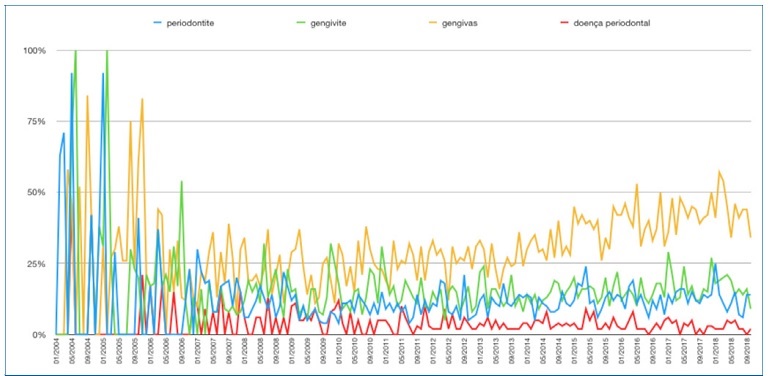
Figure 4 Evolution of web search trends in Portugal, between 2004 and 2017, on the following periodontal diseases terms: “Periodontite” (“Periodontitis”), “Gengivite” (“Gingivitis”), “Gengivas” (“Gums”) and “Doença Periodontal” (“Periodontal Disease”), according to GoogleR Trends.

Table 2 Correlation between GoogleR Trends search terms and between GoogleR Trends data and GBD data over the period 2004-2017.
The 2005 and 2008 PNPSO surveys had no information regarding periodontal diseases. The 2015 PNPSO survey investigated the periodontal status of participants aged 18, 35-44 and 65-74 years. The 18-year-old participants did not show prevalence of periodontal diseases, while participants aged 35-44 and 65-74 years old had a prevalence of 10.8% and 15.3%, respectively.
Due to the lack of previous data from the 2005 and 2008 surveys, a comparative analysis was not possible.
Table 2 represents the correlation between GoogleR Trends and GBD data over the period 2004-2017. No significant correlation was found between GBD data and GoogleR Trends search terms, except for the term “Gingivitis,” which was significantly negatively correlated (ρ=-0.537,P=0.048).
Discussion
GoogleR Trends is a modest, reliable tool to research the epidemiologic tendency of specific diseases or groups of symptoms,12and has been investigated for surveillance of disease outbreaks like dengue, malaria, enteric fever and the flu.13-17
Furthermore, GoogleR Trends has also been used to examine the impact of HIV/AIDS news coverage on web searches in Hong Kong,18and to investigate and monitor the interest on toothache information by GoogleR users from the United States, United Kingdom, Australia, and Brazil.21,22Nevertheless, this is the first study that uses GoogleR Trends to analyze the population awareness/interest for terms related to periodontal diseases on the web. GoogleR Trends should not substitute the value of epidemiological data until the usefulness of ‘‘digital epidemiology” becomes scientifically confirmed.12
Periodontal diseases are of great clinical and symptomatic variety,23-25have a great impact on the quality of life,26and are a serious public health problem. Over the last two decades, the burden of periodontal diseases increased by 57.3% worldwide.2,27,28Although the results of this study report a low prevalence of periodontal diseases in Portugal, it should be pointed out that people tend to be diagnosed already in moderate to severe states.29Besides, periodontal diseases have not figured in the most disabling diseases top rank, according to the 2017 Portugal GBD data, which in our opinion reflects the lack of public consciousness of the oral well-being status.30
According to the available GBD data, periodontal disease prevalence in Portugal has been increasing in recent years and is above the global average. However, the three age groups studied (15-49, 50-69 and 70+ years) presented a consecutive decrease in the last decade. These results are in line with the conclusions of the 2015 DGS National Oral Survey,10and a recent open-cohort study with over twenty thousand patients from a private Portuguese rehabilitation center.31Notwithstanding, there are still some reservations about these data since they clearly contradict global GBD forecasts,2and alternative studies show that this prevalence may be higher.32,33This matter is of particular relevance, since these data remain unclear, not only for Portugal but in a global way, thus requiring an urgent investigation of the prevailing data on the prevalence of periodontal diseases.
Additionally, our data point to a scarcity of medical literacy related to periodontal diseases in the Portuguese population since they prefer the term “Gums,” a more common-sense keyword, rather than “Gingivitis,” “Periodontitis,” and/or “Periodontal disease.” These results show an apparent low oralhealth literacy by the Portuguese population for periodontal diseases. Research exploring the relationship between health literacy and health outcomes found that subjects with low health literacy or health illiteracy contribute to a variety of adverse health behaviors and outcomes.34-37Moreover, the apparent negative correlation between GoogleR Trends “Gingivitis” term and GBD data might support this seemingly low medical literacy, though more studies on this topic are warranted.
Therefore, future research is necessary to study the degree of oral-health illiteracy among our population in order to guide future awareness campaigns and public health interventions on periodontal diseases.
We have also investigated if a short instrument as the Illness Perception Questionnaire (Brief‐IPQ) would be appropriate to determine the patients’ self-perception of gingivitis and periodontitis. Overall, the Brief‐IPQ proved to be a reliable instrument to be employed in periodontal research.38
This type of study and the use of these databases present some limitations. First, the coverage of diseases by these platforms depends on media coverage and is influenced by the media request.12Moreover, until this ‘‘digital epidemiology” is completely scientifically proven to be reliable, its reliability will remain questionable, though its worldwide importance is indisputable.39
Lastly, future research on the real prevalence of periodontal diseases in Portugal is mandatory. The latest Study of Periodontal Health in Almada-Seixal (SoPHiAS) revealed a disturbing prevalence of periodontitis of 59.9% among the population of the South Lisbon Metropolitan Area.40The reasons why the results of SoPHiAS differ from DGS’s and are in line with worldwide data relies on the periodontal diagnostic methodology used on the DGS studies, which have a high bias, as previously proven by our group.11
Conclusions
According to the GBD data, the overall prevalence of periodontal diseases in Portugal is continuously growing and above the world average. GoogleR Trends data show an apparent oral medical illiteracy related to periodontal diseases in the Portuguese population. Portuguese netizens predominantly tend to search for non-medical terms like “Gums” over more scientific terms like “Gingivitis,” “Periodontitis” or “Periodontal disease.”
However, overall, digital awareness for the subject of periodontal diseases has increased over time.













